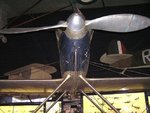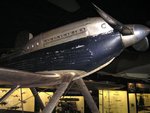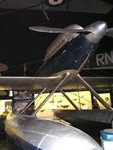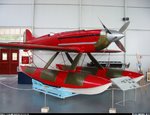SM79Sparviero
Airman
If the rules had forced all the racers to use the same fuel I don't think that it would have been so easy for British engineers and pilots.
Supermarine S6 got a speed record of 655 Km/ h during the edition of september 1931 , with 2783 HP and a maximum pressure of 2.45 BARs from the supercharger and a M.E.P of 20 BARs (!).
Such performances would have been impossible for overheating and premature detonation troubles in the cylinders without a special kind of fuel projected by chemical engineer F.R Banks of Associated Ethyl.
A special fuel which could be only formally called "gasoline" since neither a drop of gasoline was in the tanks of Supermarine S6: 60 % Methilic alcohol, 30% benzylic alcohol, 10 % acethic acid for a fast evaporation in the carburettor to cool the air/fuel mixture and a sufficiently good caloric power to limit the consumption, + 11.1 parts/1000 of TEL to prevent premature detonation.
In Italy nobody knew anything about special fuels in 1930.MC 72 could express the superlative power of 3100 HP and the consequent speed record in few months without significative breakdowns or other troubles, thanks to the consulence of engineer Banks after the expiration of his agreement with Rolls-Royce.The fuel employed for the record was not as "exotic" as the one used by Rolls-royce: 55% gasoline, 23% ethilic alcohol, 22% benzylic alcohol + 1.5 parts/ 1000 of TEL.It was less polluting as well!
Italians had to project by themselves the first in-line tandem-style twin engine in the world, a reliable aeronautical supercharger ,a new fuel for racing purpose.....starting from zero, with their poor resources they challenged a giant as British Empire.Just to face such challenge was a success in itself....
Supermarine S6 got a speed record of 655 Km/ h during the edition of september 1931 , with 2783 HP and a maximum pressure of 2.45 BARs from the supercharger and a M.E.P of 20 BARs (!).
Such performances would have been impossible for overheating and premature detonation troubles in the cylinders without a special kind of fuel projected by chemical engineer F.R Banks of Associated Ethyl.
A special fuel which could be only formally called "gasoline" since neither a drop of gasoline was in the tanks of Supermarine S6: 60 % Methilic alcohol, 30% benzylic alcohol, 10 % acethic acid for a fast evaporation in the carburettor to cool the air/fuel mixture and a sufficiently good caloric power to limit the consumption, + 11.1 parts/1000 of TEL to prevent premature detonation.
In Italy nobody knew anything about special fuels in 1930.MC 72 could express the superlative power of 3100 HP and the consequent speed record in few months without significative breakdowns or other troubles, thanks to the consulence of engineer Banks after the expiration of his agreement with Rolls-Royce.The fuel employed for the record was not as "exotic" as the one used by Rolls-royce: 55% gasoline, 23% ethilic alcohol, 22% benzylic alcohol + 1.5 parts/ 1000 of TEL.It was less polluting as well!
Italians had to project by themselves the first in-line tandem-style twin engine in the world, a reliable aeronautical supercharger ,a new fuel for racing purpose.....starting from zero, with their poor resources they challenged a giant as British Empire.Just to face such challenge was a success in itself....











